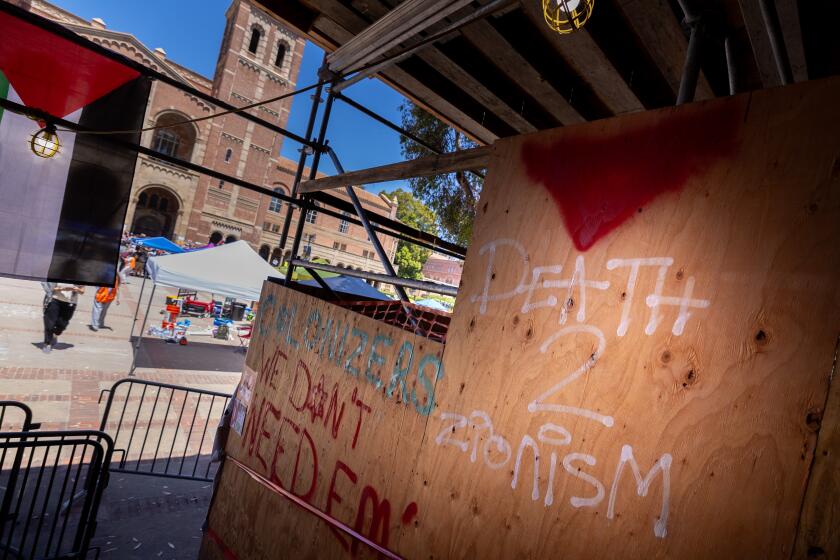Soldier’s death under U.S. fire called criminal
The death of a British lance corporal whose armored vehicle was mistakenly incinerated by a U.S. warplane in Iraq in 2003 was “criminal” and “entirely avoidable,” a coroner ruled Friday.
The British inquest’s search for investigative material on the case was marked by repeated military roadblocks, but Assistant Deputy Coroner Andrew Walker concluded that the “friendly fire” incident showed evidence of error on the part of U.S. pilots.
Contradicting the findings of a U.S. inquiry, which concluded that the incident was a “tragic accident,” the Oxfordshire examiner said the pilots should have flown lower in order to positively identify the British convoy, which they believed to be Iraqi, before opening fire.
“I don’t think this was a case of honest mistake. There is no evidence the pilots were acting in self-defense,” Walker said.
“The attack on the convoy amounted to an assault,” he added. “It was unlawful, because there was no lawful reason for it, and in that respect it was criminal.”
Attorney Geraldine McCool, representing the family of 25-year-old Lance Cpl. Matty Hull, said the coroner’s ruling was important because it concluded that the pilots operated outside the normal rules of engagement.
“It’s significant in that it shows that there was serious misconduct by the pilots. It’s the most culpable verdict that we have in this case,” she said.
The coroner’s ruling carries little legal weight, as the U.S. military is not within its jurisdiction. But family members said it ended their search for an explanation of how Hull died. Four other British soldiers were injured in the attack.
“All of our family feel it’s the right verdict. It’s what we’ve waited four years to hear, and it’s just a great sense of relief that it’s over,” Hull’s widow, Susan, said at a news conference. “But what that means for us is that it was entirely avoidable.”
The case drew international attention after the release of a video showing the shooting by the American A-10 plane and recording the agonized voices of the pilots as they realized their mistake. The existence of the video had not been revealed until it was reported by the Sun newspaper.
The pilots saw orange panels characteristic of allied forces on the roofs of the armored vehicles, but were assured there were no “friendly” forces in the vicinity. After spending five minutes trying to make a positive identification, they concluded that the vehicles were carrying Iraqi rocket launchers, and opened fire. Almost immediately, they were alerted to their mistake and called off a third strike.
The pilots were distraught, and one began weeping. “I’m going to be sick,” said one.
“Yeah, this sucks,” said another.
“We’re in jail, dude,” the first pilot said.
The coroner, who has jurisdiction because most British military casualties from Iraq are transported into Oxfordshire, obtained the video only after its appearance in the media. A copy had been in the possession of the British Defense Ministry, which said it did not have authority to release it.
The coroner was also unable to obtain testimony from the U.S. pilots. Under standard procedures, the United States does not allow its military personnel to be queried by foreign tribunals. Walker also was rebuffed in his requests for copies of U.S. rules of engagement and the pilots’ training records.
Walker’s ruling was based on copies of British rules of engagement, and written clarification on U.S. rules provided to the court.
“I believe the full facts have not yet come to light,” Walker said in his ruling.
This week, Hull’s family made a public appeal to the American government to release the contents of 11 lines that were redacted from the U.S. investigation report disclosed to the coroner’s inquest.
“To President Bush and the U.S. government: we implore you to release the 11 lines and let the coroner have these today, so that our family can feel more satisfied with the transparency of this inquest,” Hull’s widow said in a statement earlier this week.
Army Lt. Col. Mark Ballesteros, a Pentagon spokesman, said portions of the report were redacted “for security, privacy or other reasons.”
“The U.S. involved the U.K. military authorities directly in its investigation into this tragic incident and shared with U.K. military authorities all information developed during the investigation,” Ballesteros said, implying that the British authorities had access to the redacted material.
In its own inquiry, completed in 2004, the British military found that shortfalls in communications, limited training, insufficient time to complete liaison between U.S. and British forces, confusing markings on the British tanks, and high “task load” on the part of one of the U.S. pilots all contributed to the incident.
The U.S. inquiry, Ballesteros said, found the shooting to be accidental.
“The investigation determined that the incident took place in a complex combat environment, the pilots followed applicable procedures and processes for engaging targets, believing they were engaging enemy targets,” he said.
The British Defense Ministry issued an apology “for confusion and upset caused over the handling of the cockpit footage” and said the inquest “has highlighted the need for a more coherent approach to the management of documentation and evidence.”
More to Read
Start your day right
Sign up for Essential California for news, features and recommendations from the L.A. Times and beyond in your inbox six days a week.
You may occasionally receive promotional content from the Los Angeles Times.






